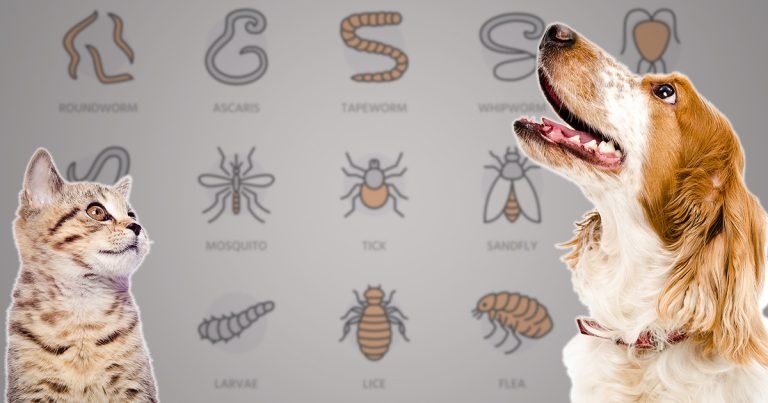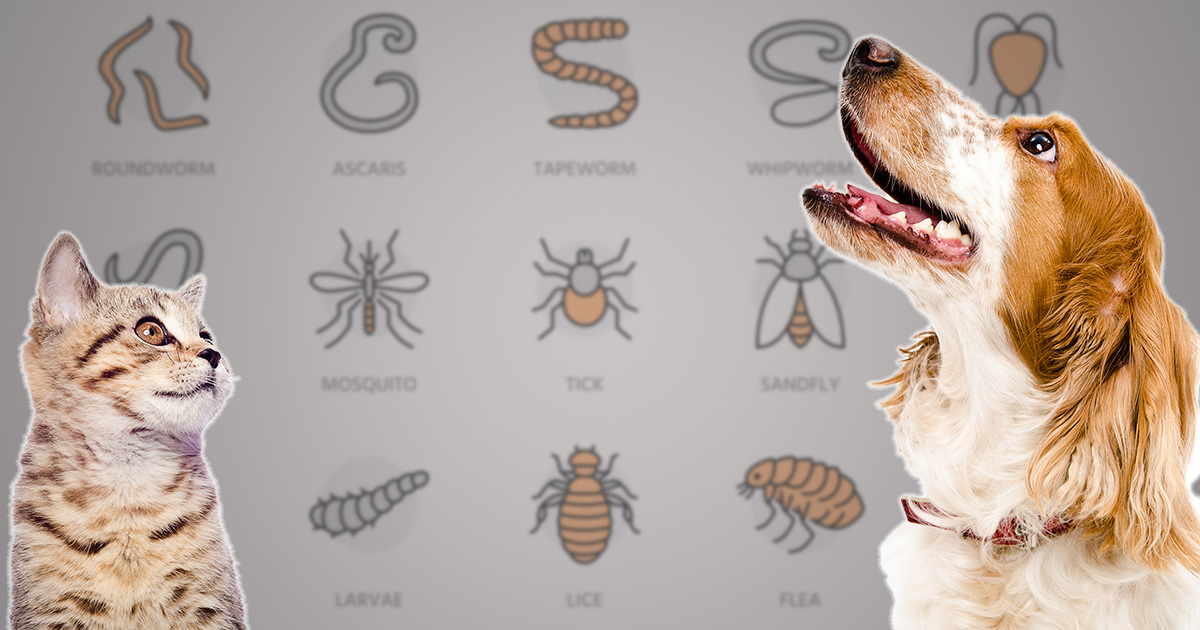8 Oct 2024
Ian Wright looks at the risk assessments and preventive methods to ensure health of companion animals.

Background image © nadiinko / Adobe Stock. Animals © sonsedskaya / Adobe Stock
Cats and dogs are exposed to a wide range of parasites with zoonotic potential, as well as pet health and economic impacts.
Surveillance plays a vital role in assessing the risk these parasites pose when developing parasite prevention plans. It is also essential in helping to prevent the establishment of new parasites and vectors in the UK and monitoring their spread when they arrive.
Responsibility for this surveillance falls upon government and research institutions, but individual vets and nurses in practice also have an invaluable role in collecting, publishing and distributing data.
Keywords: parasites, surveillance, zoonoses, diagnostics
Cats and dogs are exposed to a wide range of parasites capable of affecting pet or human health. Some, such as Taenia species and Neospora caninum, also have significant economic impacts on farms and breeding establishments.
Routine preventive treatment is required to control some of these parasites based on risk assessment.
For others, such as Giardia and Toxoplasma species, this is not possible, and other preventive measures such as hand and food hygiene need to be explored. Whatever preventive measures are available, surveillance for parasites is essential to the following.
● To assess national parasite distributions. To establish if specific parasites are present. If absent, they do not need to be considered in parasite control plans. The presence or absence of a parasite nationally will also inform whether preventive measures are required to prevent establishment from abroad. An example of this is Echinococcus multilocularis, a tapeworm of canids capable of causing severe zoonotic disease in humans. Compulsory treatment of dogs entering the UK has been a key component of keeping the UK free of the parasite. Surveillance of foxes for E multilocularis has helped to demonstrate that it is not present and that the treatment should be kept in place.
● To assess local parasite populations. Some parasites, such as Angiostrongylus vasorum, are known to be widely spread in the UK, but not uniformly, with focal areas of very high prevalence and other areas remaining free of infection. Information on local parasite distributions allow geographic, as well as lifestyle, risk to be considered when developing parasite prevention plans.
● To screen for exotic parasites entering the UK. Early diagnosis of exotic infections is important to minimise potential zoonotic exposure, plan for treatment of any pathogens present and limit the risk of exotic parasites establishing in the UK.
● To look for seasonal changes in parasite distributions. While evidence exists of year-round exposure of pets to fleas and ticks in the UK, data on exposure rates at different times of year helps to establish if that exposure is uniform or increases seasonally. Real-time tick data from studies have shown increases in activity exposure risk in spring, summer and winter, with potential for exposure year round (Abdullah et al, 2016; Wright et al, 2018). Similar robust data does not yet exist for UK fleas.
● To gather data to investigate possible risk factors for parasite exposure. By examining prevalence and infection rates in different breeds, ages and lifestyle of pets, potential risk factors can be identified that may be useful when assessing parasite exposure risk.
Surveillance can take place at a national or county level, organised by government or research institutions. Veterinary professionals in practice also play an invaluable role in gathering data through routine testing of healthy pets, as well as diagnosing and recording clinical cases of parasitic disease.
Due to financial constraints and the use of public money, government bodies are only likely to contribute to the surveillance of pathogens that are deemed a significant economic or public health risk.
This means many cat and dog parasites without zoonotic potential or cross-infection potential with horses or livestock are likely to fall between these stools. Nevertheless, governmental bodies can contribute to surveillance in the following ways.
● Making diseases reportable and notifiable. If pathogens are deemed a sufficient risk to UK biosecurity, they may be made notifiable or reportable. An obligation exists to report infections falling into this category, such as E multilocularis, rabies (notifiable) and Brucella canis (reportable). Recording and tracing of cases is also in place for these organisms, improving surveillance and the chances of spread of infection being limited or stopped. Notifiable diseases also require additional steps to limit spread depending on the infection involved. Further information can be found at bit.ly/3ZE0O2U
● Collecting, logging and mapping of parasite samples. Government provides services for the free identification of ticks, mosquitoes and exotic worm-like parasites (bit.ly/4eiOZ70; bit.ly/4eHpEDD; bit.ly/3M3oNkb). These are useful for identifying parasitic infections and potential pathogen exposure in individual patients. It also allows a picture of the distribution of these parasites and vectors across the UK, their seasonality and risk factors for exposure.
● Funding prevalence studies. Government funding through APHA and Defra is sometimes available for parasite prevalence research. For grants to be made available, however, evidence of existing risk of disease or parasite exposure is often required. Collaborations are, therefore, most common for expansions on existing data.
● Providing hubs for data collection. Often, the difficulty with surveillance is not data being generated, but where that data can be recorded and collated. Government provides some logistical support in this regard for data it collects itself and for reportable and notifiable diseases.
Opportunities exist, however, for government agencies to also perform the same role for cases of non-reportable and notifiable exotic parasitic infections recorded by vets such as heartworm, Leishmania and tick-borne pathogens. Government-collected data from the Dog and Cat Travel and Risk Information voluntary reporting scheme for exotic pathogens between 2003-08. This, however, is no longer the case. The scheme during its activity had relatively few cases submitted. If a similar scheme was launched now, increased numbers of exotic infections in imported pets and increased awareness would likely lead to increased use.
Lobbying of governments by veterinary groups such as the BVA, charities and individuals will help to keep current measures and schemes in place while hopefully expanding the state’s role in future surveillance.

Prevalence studies carried out by research groups and institutions are invaluable in helping to establish parasite distributions over wide areas, and establish potential risk factors for exposure.
They have the disadvantage of often being expensive, taking a long time to complete and dating quickly, but do provide information that is difficult to obtain through individual veterinary practices working alone. Recent examples have included the Big Tick Project and Big Flea Project giving an indication of the national distribution of fleas and ticks in the UK (Abdullah et al, 2016; Abdullah et al, 2019).
They also provided information of vector-borne pathogens that fleas and ticks carry, and the potential risks of zoonotic exposure – especially for flea-borne pathogens where infestations occur in the home (Abdullah et al, 2018; Abdullah et al, 2020). Prevalence studies carried out in foxes to establish national distributions of the canine lungworm A vasorum were not only useful in establishing its presence across Britain, but also mapping its spread from original foci in Wales, the south-west and south-east of England (Morgan et al, 2008; Taylor et al, 2015).
No recent similar studies exist for intestinal parasites, and this data gap poses a significant problem in identifying areas of high risk for parasites with geographic foci and zoonotic risk, such as Echinococcus granulosus.
In the absence of this data, risk assessments are currently made for this parasite on lifestyle (consumption of raw or undercooked offal, access to fallen carcases or unmonitored off-lead activity), except for a few known foci such as Powys in Wales and the Western Isles of Scotland, where it is known to be highly endemic.
In these regions, any dogs with off-lead activity should also be treated. Areas thought to be free of E granulosus, such as Northern Ireland, have had no recent prevalence studies to confirm this.
Although no national data exists for the zoonotic roundworm Toxocara species in cats and dogs, some surveys have shown massive environmental contamination with eggs in public spaces with the potential for human exposure (Airs et al, 2022).
Longitudinal shedding studies for Toxocara species in cats and dogs would help to establish how much untreated pets are contributing to this contamination, and whether deworming strategies could be targeted or should remain more general for this parasite.
Even where routine preventive treatments are possible and desirable, diagnostic testing has a number of benefits. It is useful in establishing the distributions of parasites at a local level, monitoring the effectiveness of parasite control programmes and helping to assess local risk.
Rapid diagnosis in clinical cases also improves prognostic outcomes and helps to limit parasite spread. Screening of imported dogs for exotic tick-borne diseases helps to maintain biosecurity and to plan for the potential development of long-term disease in the patient.
Once parasite testing has been carried out, however, the question then arises of how to best log and publicise the data acquired to help inform wider parasite disease surveillance, and the following actions should be considered.
● Inform local practices of novel parasites diagnoses. Where cases of parasitic infections diagnosed in practice are identified that have rapid changes in geographical prevalence, such as A vasorum or Borrelia burgdorferi are identified, it is helpful to notify other local practices. This local sharing of data helps to inform risk assessments, but also allows rapid identification of clinical cases if new pathogenic agents have established locally. During the Babesia canis outbreak in Essex, sharing of case information between practices helped early identification of cases, improving prognostic outcomes and limiting spread (Wright, 2018).
● Share parasite cases on social media and practice websites. Anonymising and sharing cases on social media helps to raise awareness among pet owners, as well as other veterinary practices.
● Send ticks and exotic worms to surveillance schemes. Using government recording schemes will help to populate parasite distribution data sets, build data on risk factors for exposure and confirm diagnosis for the individual patient.
● Join practice data recording groups, such as SAVSNET. SAVSNET harnesses electronic health data from registered practices, enabling real-time data to be gathered on a wide range of diseases, including those caused by parasites.
● Publish case reports. Publishing peer-reviewed case reports can be a time-consuming and work-intensive process. While this process is valuable, individual cases of novel parasites and routes of transmission can also be highlighted through letters to non-peer review sections of journals such as Veterinary Record’s letters page or publications such as Vet Times.
Cases of Leishmania species and Linguatula serrata in the UK have both recently been published this way (McGrotty et al, 2023; Campbell and Jones, 2023).
Veterinary surgeons and nurses also have a valuable role to play in larger parasite studies. Funding for prevalence studies is often based on evidence of a parasite being present or of clinical importance, so case reports and local data help to make further funding available. Funds are also becoming available for practice-based studies through charities and not-for-profit organisations such as the European Scientific Counsel Companion Animal Parasites.
Practice-based studies are useful in helping to establish local parasite prevalences and contributing to larger data sets.
All of this begins with diagnostic data generation within practice. Without testing pets for parasites, no parasite distribution maps can be produced.
The availability of highly efficacious ectoparasites and the need for routine deworming of many pets to prevent disease and zoonotic exposure may make the need for parasite testing in practice seem increasingly redundant.
It is still vital, however, for the monitoring of treatment efficacy, as part of the work-up of clinical cases and in the screening for exotic parasites in travelled pets.
Using data generated in practice alongside larger prevalence studies and government-run schemes will continue to build up a picture of the parasite risk in cats and dogs that the UK faces, and the measures required to control it.